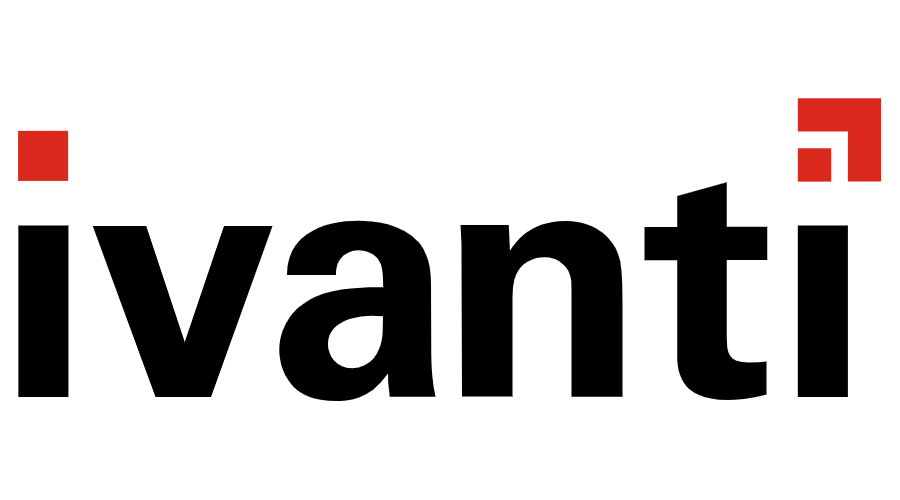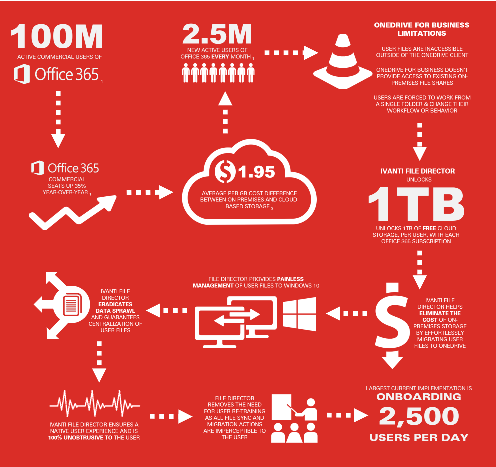
Categories
Problems that solves
No control over data access
Total high cost of ownership of IT infrastructure (TCO)
No centralized control over IT systems
No automated business processes
Non-compliant with IT security requirements
Decentralization of management
Insufficient risk management
Values
Reduce Costs
Ensure Compliance
Centralize management
Ensure Security and Business Continuity
Manage Risks
Ivanti File Director
IVANTI FILE DIRECTOR: CENTRALIZE USER FILES, AUTOMATE WINDOWS 10 MIGRATION, AND TAKE CONTROL OF ONEDRIVE AND GOOGLE DRIVE.
About Product
Description
Ivanti® File Director enables effortless migration and sync of user files from the local desktop to onpremises or cloud storage, simplifying desktop migration, eliminating data sprawl, and ensuring centralized back-up of corporate data.
Effortless File Migration
Ivanti File Director helps you reap the benefits of Office 365’s free 1TB per user of OneDrive for Business storage. This simplifies the move to the cloud and helps user adoption of Office 365.
Reduce Data Center Storage Costs
With File Director, you can ensure that important business-file data is synced from all devices into one centrally managed location. This can save huge amounts of money caused by downtime, lost data, and compliance issues.
Eliminate Virtual Private Networks (VPNs) File Director eliminates the need to implement VPNs for access to file storage, removing user connection headaches and IT support issues.
Key Feature: Total Sync Control
File Director’s granular control syncs user files to onpremises or cloud storage (OneDrive and Google Drive for Business), and also to every device the user employs. Sync occurs in the background, on demand, or in real time. IT can control which files sync by type, age, size, and path to ensure only relevant content is uploaded to corporate storage.
Elective sync methods allow users access to files as needed, without incurring costly storage or bandwidth penalties associated with limited local disk resources or slow network links.
File Director’s efficient delta sync ensures large files, including in-use Outlook PST files, can be synced from endpoints, sending only relevant changes. This reduces network traffic and sync time significantly and provides complete endpoint coverage of users’ data requirements.
Key Feature: In-Location Sync
The In-Location Sync feature ensures user files are synced to on-premises or cloud storage from their current folders and locations. Files within a user’s existing profile are synced automatically from their current location, for example, from the Desktop, Documents, Pictures, or Downloads folders, without redirection or file copies. The feature also ensures that applications work as before, and that Windows Search can still index them.
Users continue to save their files locally on their endpoint, in the usual folders, without having to move or copy them to a specific folder for them to be synced. This eliminates the need for user re-training, as all file-sync and migration actions are imperceptible to the user, and ensures a native user experience.
Key Feature: Mapped Drive Emulation
Usually in Windows when a file share is mapped to a drive letter, the files become inaccessible when the user goes offline. This can lead to user dissatisfaction, productivity loss, and additional complexity associated with VPN connections and support.
File Director’s Mapped Drive Emulation lets users view and access files on mapped drives even when offline. All content is searchable and files that have been accessed before going offline remain accessible for viewing and editing.
Any files that are edited offline are then synced automatically to on-premises or cloud storage as soon as a network connection becomes available.
Key Feature: Ghost and Placeholder Files
The sync mechanism included with File Director enables users to list files held centrally in your on-premises or cloud storage without first having to download the files locally. This introduces huge savings on network usage, particularly for devices being used over limited bandwidth connections, and allows users to search files while offline.
Key Feature: Cache Management
Cache Management provides administrators with a method to deliver up to 1TB of cloud or on-premises storage to users, regardless of the disk space available locally. File Director can both deliver and clean up files when the user has finished working with them.
On RD Session Host and VDI—particularly where disk space is limited—File Director removes the headache of server or cloud storage exceeding the disk space available on the server, ensuring a seamless experience for the user regardless of desktop platform or storage type.
Key Feature: Hardened Data Center Virtual Appliance
File Director is delivered in a hardened virtual appliance that can be utilized on-premises or within a hybrid or full cloud environment.
- Make Windows 10 Migration Effortless: Ivanti File Director makes migrations fast, secure, and easy for users, with immediate file availability on their new Windows 10 desktop using the same folder structure.
- Cater for Replacement Devices: Eliminate downtime associated with lost, stolen, or replacement desktop devices, and reduce break/fix or managed service costs with easy recovery of user files.
- Roam User Files between User Sessions: Ensure user files are instantly accessible between sessions on different desktop devices, whether physical, virtual, or cloud-hosted desktops.
- Make Corporate Data Available On-the-Move: Deliver secure file access to mobile workforces through native Windows, macOS, iOS, Android, and Web clients. Save a file on your Windows desktop and access it instantly on your smart phone or vice versa!
Ivanti File Director helps you reap the benefits of Office 365’s free 1TB per user of OneDrive for Business storage. This simplifies the move to the cloud and helps user adoption of Office 365.
Reduce Data Center Storage Costs
- By syncing files to OneDrive for Business, you can reduce the cost of on-premises storage for user files and potentially eliminate it completely. This can save your organization thousands of dollars in infrastructure and maintenance costs.
- With File Director acting as a broker, IT has complete visibility of how OneDrive storage is being used. And by providing a native user experience without the need for special folders or awkward redirection, no longer must users turn to alternative shadow IT solutions, which are inherently insecure and can lead to compliance issues.
With File Director, you can ensure that important business-file data is synced from all devices into one centrally managed location. This can save huge amounts of money caused by downtime, lost data, and compliance issues.
Eliminate Virtual Private Networks (VPNs) File Director eliminates the need to implement VPNs for access to file storage, removing user connection headaches and IT support issues.
Key Feature: Total Sync Control
File Director’s granular control syncs user files to onpremises or cloud storage (OneDrive and Google Drive for Business), and also to every device the user employs. Sync occurs in the background, on demand, or in real time. IT can control which files sync by type, age, size, and path to ensure only relevant content is uploaded to corporate storage.
Elective sync methods allow users access to files as needed, without incurring costly storage or bandwidth penalties associated with limited local disk resources or slow network links.
File Director’s efficient delta sync ensures large files, including in-use Outlook PST files, can be synced from endpoints, sending only relevant changes. This reduces network traffic and sync time significantly and provides complete endpoint coverage of users’ data requirements.
Key Feature: In-Location Sync
The In-Location Sync feature ensures user files are synced to on-premises or cloud storage from their current folders and locations. Files within a user’s existing profile are synced automatically from their current location, for example, from the Desktop, Documents, Pictures, or Downloads folders, without redirection or file copies. The feature also ensures that applications work as before, and that Windows Search can still index them.
Users continue to save their files locally on their endpoint, in the usual folders, without having to move or copy them to a specific folder for them to be synced. This eliminates the need for user re-training, as all file-sync and migration actions are imperceptible to the user, and ensures a native user experience.
Key Feature: Mapped Drive Emulation
Usually in Windows when a file share is mapped to a drive letter, the files become inaccessible when the user goes offline. This can lead to user dissatisfaction, productivity loss, and additional complexity associated with VPN connections and support.
File Director’s Mapped Drive Emulation lets users view and access files on mapped drives even when offline. All content is searchable and files that have been accessed before going offline remain accessible for viewing and editing.
Any files that are edited offline are then synced automatically to on-premises or cloud storage as soon as a network connection becomes available.
Key Feature: Ghost and Placeholder Files
The sync mechanism included with File Director enables users to list files held centrally in your on-premises or cloud storage without first having to download the files locally. This introduces huge savings on network usage, particularly for devices being used over limited bandwidth connections, and allows users to search files while offline.
Key Feature: Cache Management
Cache Management provides administrators with a method to deliver up to 1TB of cloud or on-premises storage to users, regardless of the disk space available locally. File Director can both deliver and clean up files when the user has finished working with them.
On RD Session Host and VDI—particularly where disk space is limited—File Director removes the headache of server or cloud storage exceeding the disk space available on the server, ensuring a seamless experience for the user regardless of desktop platform or storage type.
Key Feature: Hardened Data Center Virtual Appliance
File Director is delivered in a hardened virtual appliance that can be utilized on-premises or within a hybrid or full cloud environment.
Scheme of work

Competitive products
User features
Roles of Interested Employees
Chief Executive Officer
Chief Information Officer
Chief Technical Officer
Chief IT Security Officer
Organizational Features
IT Security Department in company
Backup data center
Internet access is available for employees
GDPR Compliance












